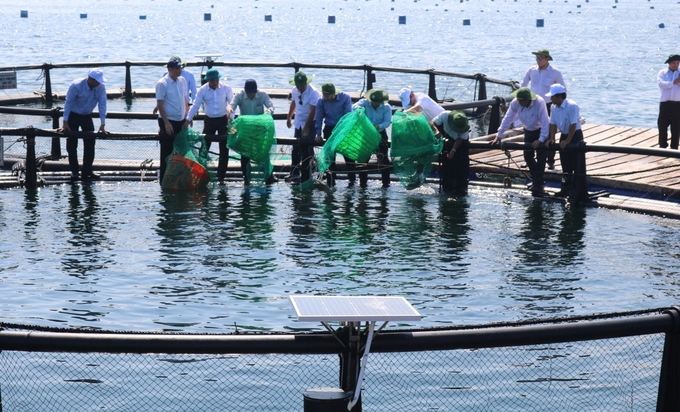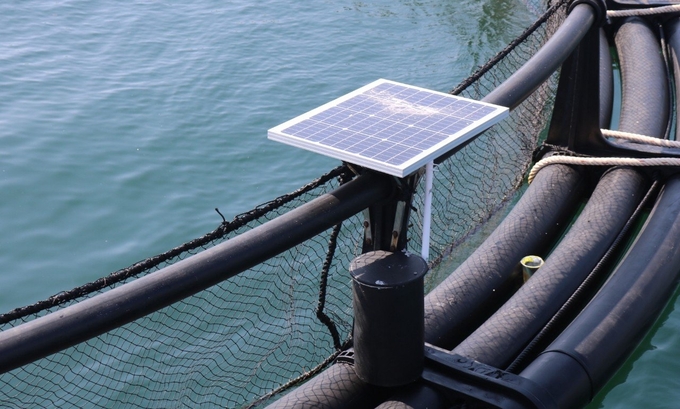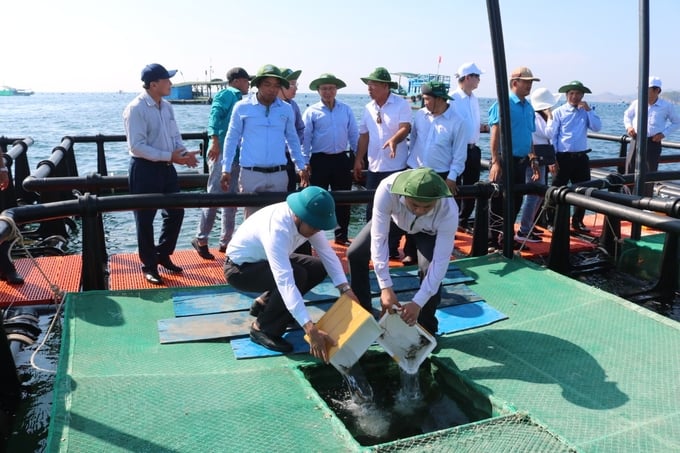June 20, 2025 | 03:38 GMT +7
June 20, 2025 | 03:38 GMT +7
Hotline: 0913.378.918
June 20, 2025 | 03:38 GMT +7
Hotline: 0913.378.918

Khanh Hoa province is focusing on developing high-tech marine farming. Photo: KS.
When converting mariculture from traditional to industrial, technological innovation is the first thing to do. Therefore, right now, Khanh Hoa province has developed an investment plan for infrastructure in concentrated farming areas, developing marine aquaculture areas in the direction of farms and industry associated with processing, applying science and technology to mariculture to ensure disease safety and improving economic efficiency.
Simultaneously, form linked aquaculture groups, move towards establishing aquaculture cooperatives at sea and link with businesses that supply and consume products to stabilize people's income.
"Our orientation on mariculture in the upcoming time is to raise key aquatic species, quickly switch to commodity production, increase the value of aquatic species per unit area, trace the origin, and ensure raw materials for processing and export industries," said Mr. Nguyen Duy Quang, Director of Khanh Hoa Department of Agriculture and Rural Development.
Phu Yen also has an investment orientation and upgrades to essential key infrastructure to meet the requirements of mariculture development associated with environmental and landscape protection. Research and apply new technology in farming, management, collection, and treatment of waste and wastewater from aquaculture and by-products associated with seafood processing to add value.

Mariculture uses HDPE cages equipped with cameras powered by solar batteries to observe the process of farming activities at sea. Photo: KS.
“In particular, we will proceed to control industrial waste sources into lagoons, bays, and beaches; Organize the collection of domestic wastewater; build a domestic wastewater collection and treatment system; limit the discharge of wastewater directly into lagoons, bays, and coastal areas; Organize trash collection activities at aquaculture rafts, lagoon areas, and along the sea," shared Mr. Nguyen Tri Phuong, Deputy Director of Phu Yen Department of Agriculture and Rural Development.
In Binh Dinh, the provincial authorities will invest in research, application, and development of new mariculture technologies to create value-added products and protect the environment. In particular, Binh Dinh will create favorable conditions for domestic and international investors to support the transfer of commercial farming technology, disease prevention and treatment, and measures to adapt to climate change for suitable mariculture species for the natural conditions of the province; Training human resources to serve management, research and production for mariculture.
“We will form a high-quality concentrated seed production area and species conservation. Diversifying mariculture objects, many mariculture objects with high economic value have the technology to proactively produce artificial seeds such as Cobia, American red snapper, sea bream, yellowfin pompano, grouper; Pacific oysters, geoduck; seaweed, grape seaweed and lobster," said Mr. Tran Van Phuc, Director of Binh Dinh Department of Agriculture and Rural Development.
Regarding technological solutions, according to experts, Vietnam's mariculture profession has two technical approaches. The first is to build its technological process, transferred from previous models in the country; The second is technology transfer from abroad. This is an area that the functional sector has not adequately organized. In the past, farmers kept learning from each other, learned from experience and then organized farming.
Technology transfer in mariculture currently has many limitations, especially technology transfer from foreign countries or foreign mariculture investors. Vietnam's mariculture profession has been developing for 10-20 years but has not been able to transfer technology to farmers, which is a significant shortcoming in policy and implementation.

Lobster stocking activities in HDPE cages in open waters in Khanh Hoa province. Photo: KS.
According to Associate Professor Dr. Vo Van Nha, Deputy Director of the Research Institute for Aquaculture No3, currently, the technology serving mariculture is quite diverse; the problem we need to solve is quality artificially produced breeds; Use industrial feed, provide automatic feed; Organic mariculture technology, using biological products in disease prevention and treatment, to ensure food safety and hygiene; improving mariculture materials, facilities, and tools; mechanization of harvesting, preservation, and processing; Using information technology, remote sensing, etc. helps reduce labor, optimize input costs, etc. These things need to be done when converting mariculture from traditional to industrial.
“Industrial mariculture needs better and different scientific and technological solutions than traditional mariculture; must reduce labor, increase animal survival rate, and be more economical. To do that, it is necessary to produce quality, fast-growing, disease-resistant breeds; Using industrial feed, automatic supply, monitoring the environment and livestock through camera systems, automatic monitoring sensors, using new materials in cage design", Associate Professor Dr. Vo Van Nha, Deputy Director of the Research Institute for Aquaculture No3, shared.
Translated by Tuan Huy
![Turning wind and rain into action: [9] Digitizing hydrometeorological data in response to climate change](https://t.ex-cdn.com/nongnghiepmoitruong.vn/608w/files/news/2025/06/17/z6704423696987_15fd32ffc26d590d204d520c9dac6786-nongnghiep-165943.jpg)
(VAN) Farmers have begun accessing hydrometeorological applications to adjust their cropping schedules, aiming to ensure productivity and adapt to climate change.
![Turning wind and rain into action: [8] Real-time salinity detection and early warning technology](https://t.ex-cdn.com/nongnghiepmoitruong.vn/608w/files/news/2025/06/17/z6704423696987_15fd32ffc26d590d204d520c9dac6786-nongnghiep-151127.jpg)
(VAN) Thanks to the integration of modern hydrological-hydraulic models, remote sensing technologies, and artificial intelligence, the accuracy of hydrological forecasting has significantly improved.
![Turning wind and rain into action: [7] Early disaster warnings help marine farmers minimize losses](https://t.ex-cdn.com/nongnghiepmoitruong.vn/608w/files/news/2025/06/17/z6704423696987_15fd32ffc26d590d204d520c9dac6786-nongnghiep-142942.jpg)
(VAN) In recent years, thanks to early disaster warnings and forecasting, marine farmers in Khanh Hoa province have been able to reduce risks and losses, thereby improving production efficiency.
![Turning wind and rain into action: [6] ‘Four on-the-spot’ disaster management software](https://t.ex-cdn.com/nongnghiepmoitruong.vn/608w/files/news/2025/06/17/e5a48259d6a262fc3bb3-nongnghiep-183800.jpg)
(VAN) By simply activating the scenario on the disaster management software, the relevant authorities immediately know how many households need to be evacuated, where to evacuate them to, and by what means of transportation…
![Turning wind and rain into action: [5] Hue applies modern technology in disaster forecasting](https://t.ex-cdn.com/nongnghiepmoitruong.vn/608w/files/news/2025/06/17/z6704423696987_15fd32ffc26d590d204d520c9dac6786-nongnghiep-093938.jpg)
(VAN) In Hue city, modern technology has recently been applied in meteorological and hydrological forecasting and warning, helping to reduce the damage caused by natural disasters.

(VAN) A cutting-edge farming technique being implemented on an experimental ranch in Arizona's Sonoran Desert has already saved a billion gallons of water over five years, according to Civil Eats.

(VAN) Poultry and pig production and the environment can be boosted through enhanced water technology, according to new research.